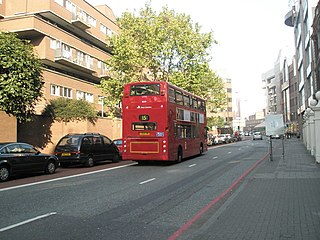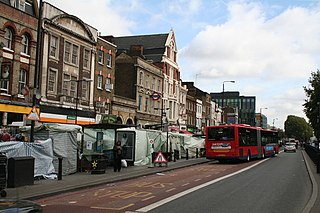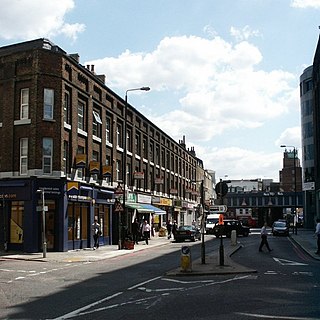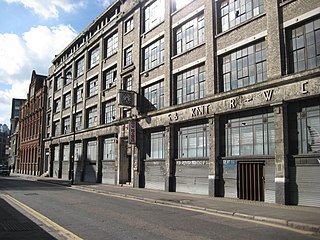
Whitechapel is a district in East London and the future administrative centre of the London Borough of Tower Hamlets. It is a part of the East End of London, 3.4 miles (5.5 km) east of Charing Cross. Part of the historic county of Middlesex, the area formed a civil and ecclesiastical parish after splitting from the ancient parish of Stepney in the 14th century. It became part of the County of London in 1889 and Greater London in 1965. The district is primarily built around Whitechapel High Street and Whitechapel Road, which extend from the City of London boundary to just east of Whitechapel station.

Mansell Street is a street in Central London, which is part of the London Inner Ring Road. For most of its length from the north, this street marks the boundary between the City of London and the London Borough of Tower Hamlets. However, the southernmost part is entirely in Tower Hamlets.

Aldgate was a gate in the former defensive wall around the City of London. It gives its name to Aldgate High Street, the first stretch of the A11 road, which included the site of the former gate.

Magdalene asylums, also known as Magdalene laundries, were initially Protestant but later mostly Roman Catholic institutions that operated from the 18th to the late 20th centuries, ostensibly to house "fallen women". The term referred to female sexual promiscuity or work in prostitution, young women who became pregnant outside of marriage, or young girls and teenagers who did not have familial support. They were required to work without pay apart from meagre food provisions, while the institutions operated large commercial laundries, serving customers outside their bases.

Minories is the name of a small former administrative unit, and also of a street in central London. Both the street and the former administrative area take their name from the Abbey of the Minoresses of St. Clare without Aldgate.

The Royal London Hospital is a large teaching hospital in Whitechapel in the London Borough of Tower Hamlets. It is part of Barts Health NHS Trust. It provides district general hospital services for the City of London and Tower Hamlets and specialist tertiary care services for patients from across London and elsewhere. The current hospital building has 845 beds and 34 wards. It opened in February 2012.

Sir John Leman (1544–1632) was a tradesman from Beccles, England who became Lord Mayor of London.

St Lawrence Jewry next Guildhall is a Church of England guild church in the City of London on Gresham Street, next to the Guildhall. It was destroyed in the Great Fire of London in 1666, and rebuilt to the designs of Sir Christopher Wren. It is the official church of the Lord Mayor of London.

Whitechapel Road is a major arterial road in Whitechapel, Tower Hamlets, in the East End of London. It is named after a small chapel of ease dedicated to St Mary and connects Whitechapel High Street to the west with Mile End Road to the east. The road is part of the historic Roman road from London to Colchester, now the A11.

St George's German Lutheran Church is a church in Alie Street, Whitechapel just to the east of the City of London. From its foundation in 1762 until 1995 it was used by German Lutherans. Today the small vestry serves as an office for the Historic Chapels Trust and the church is available for hire for secular events.

Whitechapel High Street is a street in the Borough of Tower Hamlets in the East End of London. It is about 0.2 miles long, making it "one of the shortest high streets in London". It links Aldgate High Street to the south-west with Whitechapel Road to the north-east, and includes junctions with Commercial Street to the north and Commercial Road to the east.

Leman Street was a railway station on the main line from Fenchurch Street to Blackwall in east London. It was 38 chains (0.76 km) down the line from Fenchurch Street, situated on the east side of Leman Street, near Cable Street, in the parish of Whitechapel.

Dorset Street was a street in Spitalfields, East London, once situated at the heart of the area's rookery. By repute it was "the worst street in London", and it was the scene of the brutal murder of Mary Jane Kelly by Jack the Ripper on 9 November 1888. The murder was committed at Kelly's lodgings which were situated at No. 13, Miller's Court, entered from a passageway between 26 and 27, Dorset Street.

St Mary Magdalen's Church is a Roman Catholic church in the Montpelier area of Brighton, part of the English city of Brighton and Hove. Dedicated to Jesus' companion Mary Magdalene, it is one of six Roman Catholic churches in Brighton and one of eleven in the city area. Built by ecclesiastical architect Gilbert Blount in a 13th-century Gothic style to serve the rapidly expanding residential area on the border of Brighton and Hove, it has been listed at Grade II by English Heritage in view of its architectural importance. An adjacent presbytery and parish hall have been listed separately at Grade II.

Alie Street is a 400 metre long street located in Aldgate, Central London. It links Mansell Street with Commercial Road in the East End of London. For much of its history, the western part was known as Great Alie Street, with the eastern part called Little Alie Street.

Leman Street, once known as Lemon Street, is a street in Tower Hamlets. It was built in the seventeenth century as part of the development of Goodman's Fields. It is named after John Leman who was responsible for this development, which also included Ayliff Street, Mansell Street, and Prescot Street.

Trump Street is a street in the City of London that was originally known as Trumpadere Street, probably after the trumpet or horn makers who once worked there or in the adjacent Trump Alley. It was built after the Great Fire of London (1666) but completely destroyed by bombing during the Second World War and has since been entirely rebuilt.

Stephen Peter Godin was an English insurance broker in the City of London and a land-owner in Middlesex. He acquired Cullands Grove in Southgate in what is now north London and may have built the first house on the land. He played an active part in public life and was an officer of a number of charitable organisations.

Chamber Street, once known as Chambers Street, is in the London Borough of Tower Hamlets in east London. It runs between Mansell Street in the west and Leman Street in the east, parallel with Prescot Street to the North and the London, Tilbury and Southend line to the south.

Whitechapel Mount was a large artificial mound of disputed origin. A prominent landmark in 18th century London, it stood in the Whitechapel Road beside the newly constructed London Hospital, being not only older, but significantly taller. It was crossed by tracks, served as a scenic viewing-point, could be ascended by horses and carts, and supported some trees and formal dwelling-houses. It has been interpreted as: a defensive fortification in the English Civil War; a burial place for victims of the Great Plague; rubble from the Great Fire of London; and as a laystall. Possibly all of these theories are true to some extent.





















